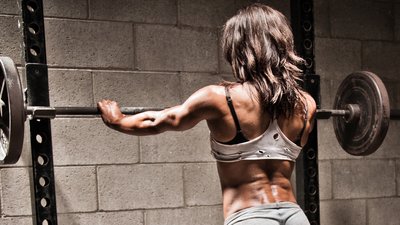Here's where the blubber meets the road: You have to dig in when trying to lose those last few pounds of body fat. You have to provide your body with enough calories and macronutrients, especially protein, to maintain your existing muscle tissue, but you also have to cut enough calories to create the necessary deficit to burn stored body fat.
It's a delicate balancing act, to be sure, but it's one that I've mastered through years of trial, error, and research. If you're struggling to shed those last few pounds, I'm here to help with eight diet, training, and supplementation tips.
1. Fiber Up Your Diet
During the final phase of any diet, the carbs you consume should be especially high in fiber—think oats, brown rice, wheat bran, fruits, and vegetables.

Nonstarchy vegetables are both high in fiber and low in calories. Whole grains are also good fiber sources.
Vegetables in particular should become a staple at all meals because they're especially fiber-rich, which will keep you full, but low in calories, which will keep you in your desired deficit.
Some of the best foods you can eat while focusing on your last few pounds of fat are nonstarchy vegetables like broccoli, cabbage, and cauliflower. Starchy vegetables like potatoes, peas, and corn are lower in fiber and higher in calories. It's a no-brainer, but this isn't ideal for your goals.
Because fibrous carbs take longer to digest than nonfibrous, starchy carbs, your pancreas doesn't have to go nuts secreting insulin for blood-glucose control. The more insulin you produce, the more your body will suppress fat oxidation, which makes it more difficult to burn fat.
The Fiber Factor
How do you know if a carbohydrate is a good source of fiber? Divide total carbohydrates by dietary fiber. The lower the ratio, the more complex (fiber-rich) the carbohydrate. Aim for a ratio of 6:1 or lower.
2. The Suckier The Workout, The Better For Burning Fat
This may seem counterintuitive, but the more efficiently you perform a cardio session, the less effectively it burns calories. If your session feels easy, that means your body has adapted to it, and it requires less energy to accomplish the task than before when you weren't as good at that activity.
One way to burn body fat is to do inefficient cardio! Like to bike? Go for a run. Like to run? Jump rope. Other options include doing everyone's favorite torture exercise, burpees, or using a heavy rope to perform high-intensity interval training (HIIT).

Embrace the suck. If your session feels easy, your body has adapted to it, so it requires less energy. (Or...HIIT training will make you so swole that you rip your training bra to shreds.) Model: @paulinenordin, founder of @fighterdiet.
Research shows that intense bursts of effort during cardio training more effectively burn body fat than steady-state work.[1] But before you cut all steady-state, remember that you benefit from both cardio approaches when your goal is to cut body fat. Why? You cannot do HIIT daily without overriding your recovery capacity. The lower-intensity sessions will still burn some calories, and those sessions require less recovery!
3. More Protein, Fewer Carbs
A mistake people often make during a cutting phase is not holding on to their muscle mass for dear life. How do you hold on to muscle mass? By consuming a lot of protein.
Protein in itself stimulates protein synthesis, or the eventual creation of new muscle tissue. Consume at least 25 grams of protein every 3-4 hours to maximize this response. This is even more important to execute at the pre- and post-workout meal.
Carbs provide your muscles with the fuel they need to perform and restore glycogen in your muscles, but they're not required to tell your muscles to "grow." That's protein's job. Keep carbohydrates centered on training to maximize your workout performance and enhance your recovery.
To further bolster muscle maintenance, be sure to include carbs post-workout, because they play a role in reducing muscle breakdown.
4. Change Your Weight-Training Strategy, No Matter What It Is
Do you like lifting heavy weights for low reps? Switch it up, and go with lighter weights and higher reps. I'm not saying you should go to the gym and do light weights and high reps to "tone" or "cut." But I want you to vary your load to make sure your body isn't working as efficiently as possible—just like the cardio scenario.

Switch up your workout periodically by changing the number of reps, the amount of weight, or the equipment you use. Model: @paulinenordin, founder of @fighterdiet.
If you don't alter how you train and force your body to adapt to a new stimulus, you'll slowly allow your muscles to train with less effort. That means muscle has no reason to stay.
5. Add A Fat Burner To Intensify Your Workout
Choose a fat-burning supplement with ingredients that work for you. Common and effective fat-burning ingredients include caffeine, green tea extract, synephrine, and capsaicin.
The only way to discover what works best for you is through trial and error. For example, caffeine is one of the most effective fat-burning ingredients on the market, but even caffeine doesn't work for everyone, and has less of an effect for those who consume caffeine on a regular basis.
When you find a fat-burning ingredient that works particularly well for you, keep in mind that your response to it may not remain the same indefinitely. Your body is smart. As it adapts to a certain ingredient, like caffeine, that ingredient won't necessarily give you the same buzz or high after a while.
This doesn't always mean that the ingredient or product has stopped working from a fat-burning standpoint. I often hear some variation of "I don't feel a kick anymore, so this ingredient must be worthless" when it comes to fat burners. This is incorrect. Just because you don't "feel" a kick doesn't mean the fat-burning effects have stopped.
If you want to reset your sensitivity to stimulants like caffeine, go decaf on the coffee for 3-5 days, and then reintroduce it. See if that buzz or high doesn't suddenly reappear.
Oh, and this should go without saying, but no matter how great a fat burner claims to be, it still can't cancel out a crappy diet. Sorry, folks.
6. Lower Your Room Temperature
Let's call this the thermic effect of having a cold ass. Set your thermostat to around 60 degrees. The colder temperature can increase the activity of your brown fat—the beneficial type of body fat that burns energy and glucose to make heat.[2] This can result in a slight increase to your resting metabolic rate and may lead to weight loss over time.
Getting chilly? Rather than layering up with a sweater or a blanket, perform a 90-second set of jump squats. That'll warm you up and encourage your body to burn more body fat. You'll also save money on your heating bill when you do this in the colder months of the year!
7. Look For Foods That Are High In Volume But Low In Calories
The advantage of "turning up the volume" on your diet with low-calorie foods is that you can consume the same amount of food as you did before, but you'll take in fewer calories, particularly from carbs. That's crucial for satiety, because your stomach demands to be filled.

Try substituting steel-cut oats for wheat bran, or shirataki noodles for rice, or spaghetti squash for pasta.
Your stomach is a volume counter, not a calorie counter. By choosing foods high in fiber and water, you will feel more quickly. When your stomach expands, it sends satiety signals to your brain to tell you to put the fork down.
Try substituting steel-cut oats for wheat bran, or shirataki noodles for rice, or spaghetti squash for pasta.
8. Include Hot Spices To Burn More Calories
Consuming spices such as cayenne pepper, or hot peppers such as ghost peppers or jalapenos, increases thermogenesis, or the production of heat in the body, which manifests from an increase in energy (calorie) expenditure.
Hot peppers contain capsaicin, which has been shown to increase energy expenditure, particularly via increased fat utilization.[3]
Even though this probably sounds contradictory, just consuming food is thermogenic! The digestion and absorption of food actually requires energy, or calories—this is known as the thermic effect of food (TEF). It just so happens that protein has the highest TEF, compared to carbohydrates and fat, which is a further reason to boost protein intake.
Photos of model @paulinenordin are courtesy of @fighterdiet. Used with permission.
References
- Trapp, E. G., Chisholm, D. J., Freund, J., & Boutcher, S. H. (2008). The effects of high-intensity intermittent exercise training on fat loss and fasting insulin levels of young women. International Journal of Obesity, 32(4), 684-691.
- van Marken Lichtenbelt, W. D., Vanhommerig, J. W., Smulders, N. M., Drossaerts, J. M., Kemerink, G. J., Bouvy, N. D., ... & Teule, G. J. (2009). Cold-activated brown adipose tissue in healthy men. New England Journal of Medicine, 360(15), 1500-1508.
- Janssens, P. L., Hursel, R., Martens, E. A., & Westerterp-Plantenga, M. S. (2013). Acute effects of capsaicin on energy expenditure and fat oxidation in negative energy balance. PloS One, 8(7), e67786.

